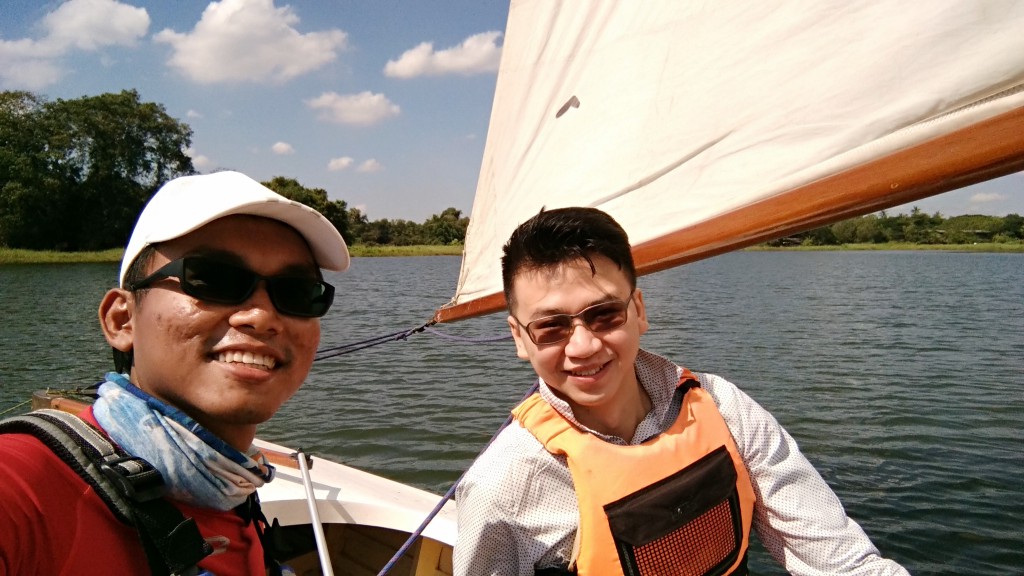As I have lived in Yangon long enough, I longed for access to large bodies of water. The only possible way in Yangon for me at this moment is to sail in Inya Lake, in the middle of Yangon. I started learning how to sail in the local club since 2016 March as a beginner sailor and started joining races as I progress in my learning ladder. Here are some lessons I have learned while sailing in Inya waters which can also be applied for startups in Myanmar.

1- If you are in a niche enough market, you will be the top of of the game.
Races in Inya Lake can be held for same boat classes, combined race or a fleet race. I once joined a combined race where various classes of boats will start off together but will be ranked according to their own class. A wide eyed beginner me joined the race having little or no clue about the rules except for safety. The race ended and what a surprise to learn I came in first in my class since mine was in the only boat in my class anyway. While I could claim bragging rights as the winner of the race, I know myself that I am nowhere near being the best sailer in the race. As a startup define their market niche enough, they could very well claim to be the best, top of the game or any other bragging rights, but in the end it’s the profits which they should use as a measure of their success.
2- Changing conditions can be a good thing
In Inya, unlike the open sea, I have observed that wind in the lake isn’t always constant, the various of even the same class could respond differently to the changing wind conditions. During races, when a wind shift occurs or when the wind conditions change, the boats which are slow in medium winds could be overtaking others during a light wind condition. If you look around enough, you can probably spot a good gust of wind that you can take advantage of that nobody have noticed either.
Myanmar’s economic and political development can be analogous to Inya’s winds, they do keep changing unlike more developed countries. Startups can use it to their advantage against bigger firms. Spot the opportunities of a gust of wind, take advantage of shifting winds, do what big companies cannot do.
3- Learning can be subconsciously done with enough motivation
The first sailing class I took was “Junior Sailor”, which was based on the sailing syllabus for Singapore Children. How to tack, gybe and how to tie knots are learnt consciously but the most learning come from just floating around the lake in a boat with my wife or in the heat of a race. That is where the formal lessons get drilled into my skin and bones.
Business and management trainings and books I took gave me knowledge on operating a startup but it’s during the execution, growing the company and competing in the market that gives me confidence and skills.
4- Aiming too high can sometimes slow you down
Most races in Inya involve sailing towards the wind (upwind) and following the wind (downwind). Since sail boats can’t possibly sail against the wind, the best possible angle is achieved by posting the boat at 45’ towards the wind. While this is in theory, the slight changes in wind condition and the geography means pointing at absolute 45’ will only slow you down. You are better off aiming at ever slightly less than 45’, try to achieve speed instead and win the race as a longer term strategy.
Same goes for startups in trying to optimise their resources. Sometimes, the best strategy is to aim and optimise for longer term market win instead of trying to optimise every resources or trying to win every deal.
5- Reduce as much drag as you can
Drag is the force which is applied to your boat from opposite direction you are trying to move. Sailors try to reduce drag as much as possible by making the boat’s hull smooth, making it sail on one of it’s edge, pulling up the centre board half way or even totally at certain sailing conditions. If you have some debris caught in your rudder, remove it immediately since they introduce more drag.
As we are trying to lift off our own startup off the ground, reduce as much unnecessary drag as possible. Keep the team lean so you won’t spend trying to entertain human resource issues instead of going out to meet customers. Keep your feature set small, bring your partners fully onboard or leave them behind for another trip, help them make that decision as fast as they can.
6- The position you took can make or brake your race (being at the place where the wind is).
It could be due to the pure luck that you started the race at just the right spot, or you entered a wind shadow with no wind at all. It could possibly be also because you planned that start of the race all along and you just had no choice to go through a zone with no wind to get to your destination.
Either you are cruising through your customer acquisition journey or stuck trying to overcome a tight technical spot, it could have been pure luck, pre-planning or something unavoidable. Whatever that is, your goal is still there and you may as well have to paddle using your bare hand through that wind shadow. If you did run your boat aground, you may have to jump off the boat for a bit and launch it again like you might have to reboot your company or start another one.
7- Competition gives you a reference and makes you learn faster (changing wind conditions wouldn’t let you compete against yourself)
Unlike other sports where you can race against your own time, sailing is tricky when it comes to that since even a lap of practice would give you better or worse results based on wind conditions. This requires you to have a competitor to give you a reference on how you are doing but not so accurately. You may be improving on your own term but if your competitor is improving much faster than you, you are still going to loose your races.
No startup is going to go through the same journey again. Even with the same team, same amount of funding, the market conditions would have been changed and you can never measure your improvement. Competitors give you a good reference on how much progress you have made and if you could possibly be doing it better.
8- Enjoy the experience even if you aren’t winning the race.
The best part of joining the race is the excitement and energy of the environment. Wind, sun, moon and the sound of water makes it all worth it in addition to the learning you get during the race regardless of your finishing position. Enjoy the race of startup and life in general. Winning would be good but even if you don’t come on top, there are things that are worth valuing along the way.
Sure, I will have more updated lessons as I progress in sailing and entrepreneurship, and will even have corrections to these lessons that I wrote of. I will keep the audience posted on them.
 Startup95 Bringing Myanmar's Startups to The World
Startup95 Bringing Myanmar's Startups to The World



